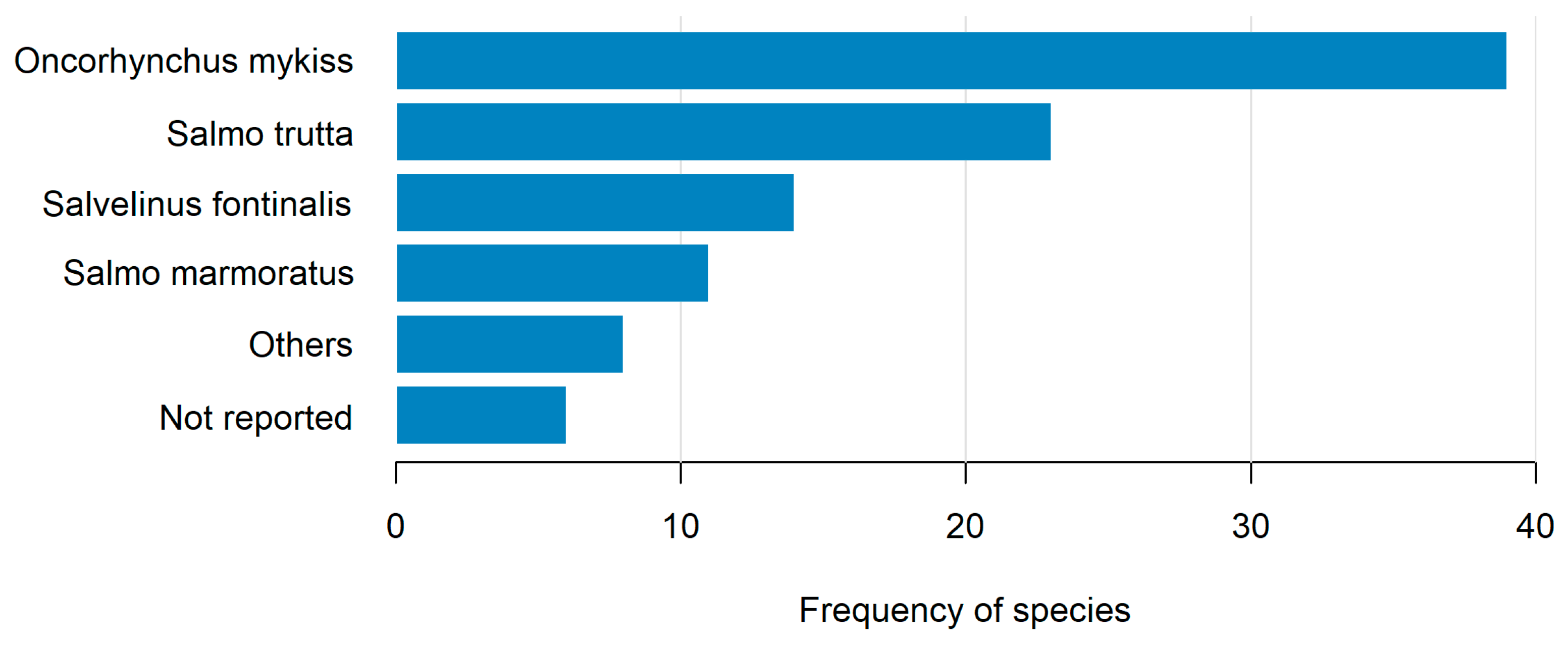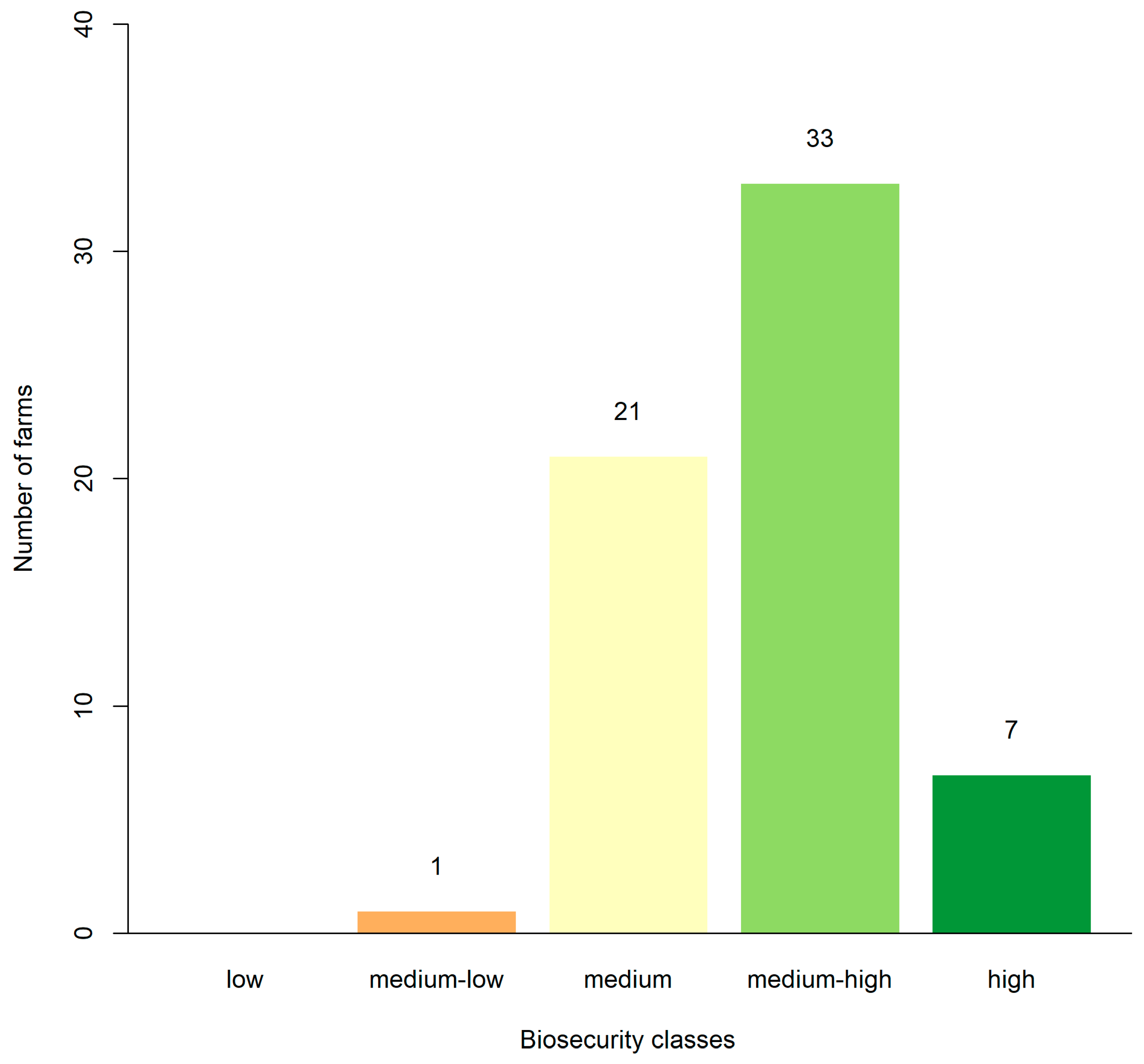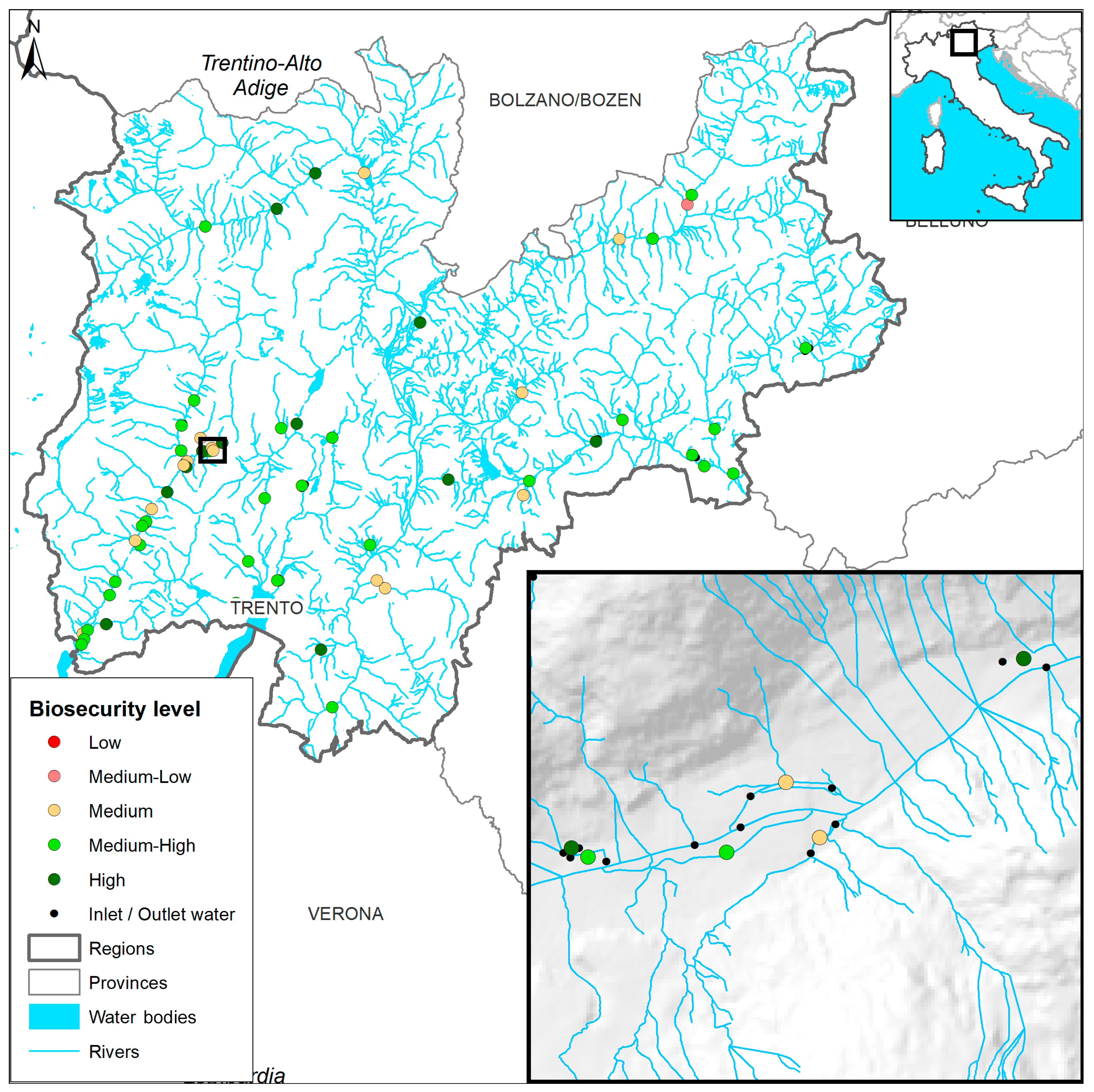Overview on the Biosecurity Measures of Salmonid Fish Farms: A Case Study in Italy
Abstract
1. Introduction
2. Materials and Methods
2.1. Farms Selection
- Activity status (“currently active” in the BDN);
- Type of production (fattening, hatchery or pre-growing);
- Direct contact with veterinarians of the Local Competent Authority (LCA), who selected the farms included in the project according to the annual total production, excluding the smaller ones.
2.2. Checklist Data Collection
2.3. Expert Opinion
2.4. Data Analysis
3. Results
3.1. Picture of the Trout Farming Sector in APT
3.2. Biosecurity Aspects
3.2.1. Structural Features of the Farm
3.2.2. Biosecurity
3.2.3. Disease Prevention
3.2.4. Feed and Medicines
3.2.5. Fishing and Fish Load
3.2.6. Registrations
3.2.7. Employees Training
3.3. Expert Elicitation and Farms Ranking
4. Discussion
- Sanitation and disinfection of the loading truck;
- Regular collection, storage, and disposal of the dead fish;
- Farm protection from ichthyophagous birds by bird nets;
- Use of dedicated equipment for different areas of the plant;
- Presence of dedicated areas for loading dead fish outside the rearing area.
5. Conclusions
Author Contributions
Funding
Institutional Review Board Statement
Informed Consent Statement
Data Availability Statement
Acknowledgments
Conflicts of Interest
References
- Food and Agriculture Organization of the United Nations. The State of World Fisheries and Aquaculture 2022; Food and Agriculture Organization of the United Nations: Rome, Italy, 2022. [Google Scholar] [CrossRef]
- FEAP Secretariat. Federation of European Aquaculture Producers European Aquaculture Production Report 2014–2020 (V1.1); FEAP Secretariat: Brussels, Belgium, 2021. [Google Scholar]
- European Commission. European Market Observatory for Fisheries and Aquaculture Products Freshwater Aquaculture in the EU; European Commission: Brussels, Belgium, 2023; Available online: https://www.eumofa.eu/ (accessed on 13 June 2023).
- Eurostat. Available online: https://ec.europa.eu/eurostat (accessed on 4 October 2023).
- EUMOFA. Freshwater Aquaculture in the EU; Maritime Affairs and Fisheries; Publications Office of the European Union: Luxembourg, 2021; ISBN 9789276384922. [Google Scholar]
- Ue, G.N.; Del, L.A.S.; Nella, P.; Di, C. Caso Studio: La Trota di Taglia Grande NELL’EU—La Struttura del Prezzo Nella Catena di Approvvigionamento—Focus su Spagna e Italia; European Commission: Brussels, Belgium, 2023. [Google Scholar]
- API—Associazione Piscicoltori Italiani—Acquacoltura Sostenibile. Available online: https://www.acquacoltura.org/ (accessed on 3 October 2023).
- Ministero delle Politiche Agricole, A. e F. Servizio di Valutazione Ex-Ante del PO FEAMP 2014–2020. 2015.
- Peeler, E. The Role of Risk Analysis and Epidemiology in the Development of Biosecurity for Aquaculture. In Diseases in Asian Aquaculture; The Fish Health Section of the Asian Fisheries Society: Manila, Philippines, 2005. [Google Scholar]
- Oidtmann, B.C.; Thrush, M.A.; Denham, K.L.; Peeler, E.J. International and national biosecurity strategies in aquatic animal health. Aquaculture 2011, 320, 22–33. [Google Scholar] [CrossRef]
- Osborn, A.; Henry, J. The role of aquaculture farm biosecurity in global food security. Rev. Sci. Tech. 2019, 38, 571–587. [Google Scholar] [CrossRef] [PubMed]
- Corbetta, P. Social Research: Theory, Methods and Techniques. In Social Research: Theory, Methods and Techniques; SAGE: New York, NY, USA, 2003. [Google Scholar] [CrossRef]
- Knol, A.; Sluijs, J.P.; Van Der Slottje, P. Expert Elicitation: Methodological suggestions for its use in environmental health impact assessments. RIVM Lett. Rep. 2008, 56, 28–35. [Google Scholar]
- Martin, T.G.; Burgman, M.A.; Fidler, F.; Kuhnert, P.M.; Low-Choy, S.; Mcbride, M.; Mengersen, K. Eliciting Expert Knowledge in Conservation Science. Conserv. Biol. 2012, 26, 29–38. [Google Scholar] [CrossRef] [PubMed]
- R: The R Project for Statistical Computing. Available online: https://www.r-project.org/ (accessed on 4 October 2023).
- PostgreSQL: The World’s Most Advanced Open Source Database. Available online: https://www.postgresql.org/ (accessed on 4 October 2023).
- PostGIS. Available online: https://postgis.net/ (accessed on 4 October 2023).
- 2008/896/EC: Commission Decision of 20 November 2008 on guidelines for the purpose of the risk-based animal health surveillance schemes provided for in Council Directive 2006/88/EC. Available online: https://eur-lex.europa.eu/legal-content/EN/TXT/PDF/?uri=CELEX:32008D0896 (accessed on 4 October 2023).
- Jensen, B.B.; Ersbøll, A.K.; Korsholm, H.; Skall, H.F.; Olesen, N.J. Spatio-temporal risk factors for viral haemorrhagic septicaemia (VHS) in Danish aquaculture. Dis. Aquat. Organ. 2014, 109, 87–97. [Google Scholar] [CrossRef] [PubMed]
- Oidtmann, B.C.; Crane, C.N.; Thrush, M.A.; Hill, B.J.; Peeler, E.J. Ranking freshwater fish farms for the risk of pathogen introduction and spread. Prev. Vet. Med. 2011, 102, 329–340. [Google Scholar] [CrossRef] [PubMed]
- Oidtmann, B.; Peeler, E.; Lyngstad, T.; Brun, E.; Bang Jensen, B.; Stärk, K.D.C. Risk-based methods for fish and terrestrial animal disease surveillance. Prev. Vet. Med. 2013, 112, 13–26. [Google Scholar] [CrossRef] [PubMed][Green Version]
- Oidtmann, B.C.; Pearce, F.M.; Thrush, M.A.; Peeler, E.J.; Ceolin, C.; Stärk, K.D.C.; Pozza, M.D.; Afonso, A.; Diserens, N.; Reese, R.A.; et al. Model for ranking freshwater fish farms according to their risk of infection and illustration for viral haemorrhagic septicaemia. Prev. Vet. Med. 2014, 115, 263–279. [Google Scholar] [CrossRef] [PubMed]
- Oidtmann, B.C.; Peeler, E.J.; Thrush, M.A.; Cameron, A.R.; Reese, R.A.; Pearce, F.M.; Dunn, P.; Lyngstad, T.M.; Tavornpanich, S.; Brun, E.; et al. Expert consultation on risk factors for introduction of infectious pathogens into fish farms. Prev. Vet. Med. 2014, 115, 238–254. [Google Scholar] [CrossRef] [PubMed]
- Sub-Committee on Aquatic Animal Health. The Aquaculture Farm Biosecurity Plan: Generic Guidelines and Template; Sub-Committee on Aquatic Animal Health: Canberra, Australia, 2017. Available online: https://www.agriculture.gov.au/sites/default/files/sitecollectiondocuments/fisheries/aquaculture/aquaculture-farm-biosecurity-plan.pdf (accessed on 4 October 2023).
- Perera, R.P.; Jones, B.; Beers, P.; Kleeman, S.; Mcgladdery, S. Maintaining Biosecurity in Aquaculture Systems: A Constraint or a Challenge? In Proceedings of the 6th Symposium on Diseases in Asian Aquaculture, Colombo, Sri Lanka, 25–28 October 2005; pp. 3–19. [Google Scholar]
- Muniesa, A.; Furones, D.; Rodgers, C.; Basurco, B. An assessment of health management and biosecurity procedures in marine fish farming in Spain. Aquac. Rep. 2022, 25, 101199. [Google Scholar] [CrossRef]




| Description | Percentage |
|---|---|
| Presence of fence and controlled access to the breeding areas. | 90.3 |
| Unloading of feed takes place outside the breeding area. | 51.6 |
| Presence of dedicated areas for disinfecting vehicles outside the breeding area. | 38.7 |
| Presence of dedicated areas for loading dead fish outside the rearing area. | 48.4 |
| Presence of a physical separation of the different facilities of the farm (e.g., hatchery, fattening, breeding stock). | 71.0 |
| Presence of a dedicated and separate area for storing equipment. | 96.8 |
| Presence of a dedicated and separate area for feed. | 91.9 |
| Presence of a dedicated and separate area for medicines and disinfectants. | 90.3 |
| Presence of a filter area/changing rooms and separate toilets. | 59.7 |
| Direct sales area separated from the breeding area. | 25.8 |
| Presence of a fish processing plant. | 12.9 |
| Presence of barriers are in place to prevent the upwelling of wild fish and escape. | 95.2 |
| Protection of farms from fish-eating birds by anti-bird nets. | 54.8 |
| Description | Percentage |
|---|---|
| Compliance with a good hygiene practice manual. | 88.7 |
| Checking of transport vehicles and their disinfection before entering. | 64.5 |
| Checking of transport vehicles and their disinfection before leaving the company. | 51.6 |
| Disinfection of footwear before entering the hatchery or fish pre-growing. | 67.7 |
| Disposable footwear and/or gowns used by visitors. | 45.2 |
| Equipment (waders, tanks, etc.) cleaned and disinfected. | 79.0 |
| Presence of signs with operational instructions. | 27.4 |
| Dedicated equipment used for the different areas of the plant. | 67.7 |
| The water entering the hatchery is sanitized. | 1.6 |
| Description | Percentage |
|---|---|
| Eggs are disinfected according to a protocol. | 43.5 |
| Mortality is regularly recorded. | 93.5 |
| Documentation of the execution of the health surveillance programme provided for in Article 11 of Legislative Decree No. 148/2008. | 88.7 |
| Presence of traceability of the clinical/laboratory diagnosis made by the breeder/health professional. | 79.0 |
| Dead fish are collected, stored, and regularly disposed in well identified containers. | 91.9 |
| Operators work exclusively on a farm. | 69.4 |
| Description | Percentage |
|---|---|
| Dead fish are removed before fishing. | 95.2 |
| Applying of the all-full/all-empty methodology. | 32.3 |
| Equipment is easily washed and kept clean. | 98.4 |
| Fish sold live are loaded using the same water in which they were housed. | 66.1 |
| The truck is owned by the farmer. | 72.6 |
| The truck is used exclusively by a single company for loading. | 58.1 |
| Truck cleaning before loading. | 90.3 |
| Truck disinfection before loading. | 77.4 |
| Description | Percentage |
|---|---|
| Presence of a logbook for visitors. | 37.1 |
| Recording of movements and keeping the loading/unloading register up-to-date. | 98.4 |
| Presence of a rodent control plan. | 62.9 |
| Animal by-products (ABP) are disposed of by specialized and authorized companies. | 88.7 |
| Aspect | Description | Average Score |
|---|---|---|
| Disease prevention | Dead fish are collected, stored, and regularly disposed in well identified containers. | 8.79 |
| Fishing and fish load | Cleaning and disinfecting the truck before loading. | 8.71 |
| Biosecurity | Dedicated equipment used for the different areas of the plant. | 8.50 |
| Biosecurity | Equipment (waders, tanks, etc.) cleaned and disinfected. | 8.40 |
| Registrations | Recording of movements and keeping the loading/unloading register up-to-date. | 8.30 |
| Biosecurity | Checking of transport vehicles and their disinfection before entering and leaving the company. | 8.29 |
| Structural features of the farm | Protection of farms from fish-eating birds by anti-bird nets. | 8.26 |
| Disease prevention | Mortality is regularly recorded. | 8.17 |
| Fishing and fish load | Equipment is easily washed and kept clean. | 8.13 |
| Feed and medicines | Presence of a treatment logbook. | 8.02 |
| Structural features of the farm | Presence of a fence and controlled access to the breeding areas. | 8.00 |
| Structural features of the farm | Presence of dedicated areas for loading dead fish outside the rearing area. | 7.97 |
| Registrations | Animal by-products (ABP) are disposed of by specialized and authorized companies. | 7.96 |
| Structural features of the farm | Presence of dedicated areas for disinfecting vehicles outside the breeding area. | 7.93 |
| Disease prevention | Eggs are disinfected according to a protocol. | 7.93 |
| Structural features of the farm | Presence of a physical separation of the different facilities within the farm (e.g., hatchery, fattening, breeding stock). | 7.86 |
| Disease prevention | Presence of traceability of the clinical/laboratory diagnosis made by the breeder/health professional. | 7.85 |
| Fishing and fish load | Appling of the all-full/all-empty methodology. | 7.72 |
| Biosecurity | Disinfection of footwear before entering the hatchery or fish pre-growing. | 7.71 |
| Structural features of the farm | Presence of a fish processing plant. | 7.70 |
| Structural features of the farm | Presence of barriers to prevent the upwelling of wild fish and escape. | 7.66 |
| Biosecurity | Disposable footwear and/or gowns used by visitors. | 7.65 |
| Employees training | Transport personnel have been adequately trained. | 7.53 |
| Fishing and fish load | The truck is used exclusively by a single company for loading. | 7.10 |
| Structural features of the farm | Presence of a filter area/changing rooms and separate toilets. | 7.03 |
| Employees training | Farm personnel have attended some refresher courses over the last three years on the topics mentioned in the notes. | 6.98 |
| Disease prevention | Documentation of the execution of the health surveillance programme provided for in Article 11 of Legislative Decree No. 148/2008. | 6.90 |
| Biosecurity | Compliance with a good hygiene practice manual. | 6.88 |
| Registrations | Presence of a rodent control plan. | 6.74 |
| Feed and medicines | Bags of feed are stored in a dry place and separated from disinfectants or other chemicals. | 6.43 |
| Fishing and fish load | Dead fishes are removed before fishing. | 6.42 |
| Fishing and fish load | The truck is owned by the farmer. | 6.36 |
| Structural features of the farm | Presence of a dedicated and separate area for storing equipment, feed, medicines, and disinfectants. | 6.34 |
| Fishing and fish load | Fish sold live are loaded using the same water in which they were housed. | 6.06 |
| Disease prevention | Operators work exclusively on a farm. | 6.02 |
| Structural features of the farm | Direct sales area separated from the breeding area. | 5.80 |
| Structural features of the farm | Unloading of feed takes place outside the breeding area. | 5.66 |
| Biosecurity aspects | The water entering the hatchery is sanitized. | 5.26 |
| Biosecurity aspects | Presence of signage with operational instructions. | 5.23 |
| Registrations | Presence of a logbook for visitors. | 5.16 |
Disclaimer/Publisher’s Note: The statements, opinions and data contained in all publications are solely those of the individual author(s) and contributor(s) and not of MDPI and/or the editor(s). MDPI and/or the editor(s) disclaim responsibility for any injury to people or property resulting from any ideas, methods, instructions or products referred to in the content. |
© 2023 by the authors. Licensee MDPI, Basel, Switzerland. This article is an open access article distributed under the terms and conditions of the Creative Commons Attribution (CC BY) license (https://creativecommons.org/licenses/by/4.0/).
Share and Cite
Mazzucato, M.; Dorotea, T.; Franzago, E.; Mulatti, P.; Marchetti, G.; Casarotto, C.; Fabris, A.; Ferrè, N.; Toffan, A.; Marsella, A.; et al. Overview on the Biosecurity Measures of Salmonid Fish Farms: A Case Study in Italy. Fishes 2023, 8, 554. https://doi.org/10.3390/fishes8110554
Mazzucato M, Dorotea T, Franzago E, Mulatti P, Marchetti G, Casarotto C, Fabris A, Ferrè N, Toffan A, Marsella A, et al. Overview on the Biosecurity Measures of Salmonid Fish Farms: A Case Study in Italy. Fishes. 2023; 8(11):554. https://doi.org/10.3390/fishes8110554
Chicago/Turabian StyleMazzucato, Matteo, Tiziano Dorotea, Eleonora Franzago, Paolo Mulatti, Giulio Marchetti, Claudia Casarotto, Andrea Fabris, Nicola Ferrè, Anna Toffan, Andrea Marsella, and et al. 2023. "Overview on the Biosecurity Measures of Salmonid Fish Farms: A Case Study in Italy" Fishes 8, no. 11: 554. https://doi.org/10.3390/fishes8110554
APA StyleMazzucato, M., Dorotea, T., Franzago, E., Mulatti, P., Marchetti, G., Casarotto, C., Fabris, A., Ferrè, N., Toffan, A., Marsella, A., Callegaro, A., Manca, G., & Dalla Pozza, M. (2023). Overview on the Biosecurity Measures of Salmonid Fish Farms: A Case Study in Italy. Fishes, 8(11), 554. https://doi.org/10.3390/fishes8110554







